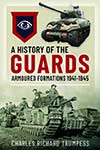|
A HISTORY OF THE GUARDS ARMOURED FORMATIONS
1941-1945
By Charles Richard Trumpess

|
Charles Richard Trumpess’s history of the Guards’ armoured formations, originally his MA thesis for Buckingham University, takes the form of a forensic study which draws on a broad spectrum of sources, some primary, most secondary and is benchmarked throughout by quoting the opinions of other military historians.
No context is provided to the reader of how British armoured divisions evolved. At the beginning of 1939, there were none except for two ‘Mobile Divisions’. Faced by the threat of imminent invasion, these were rebranded and another four created in a flurry of activity. By the time the Division was formed in the spring of 1941, there had already been three changes in the composition and structure of armoured divisions and another six were to follow.
As to operational doctrine, the problem was that British armour had played a very limited part in the BEF’s campaign. Colonel Lewis Lyne, the Chief Instructor at the Senior Officers’ School in 1940-1, found great difficulty in keeping ‘a reasonable balance in our teaching of tactics between the impressive early German victories, the evolution of our own army for future operations in Europe and the very specialised conditions of the fighting in the Western Desert’.1
All these changes in doctrine, organization and equipment conspired to create a chaotic training environment.2 At times, both the Guards Armoured Division and 11th Armoured Division struggled to keep up with them, especially when their tanks were replaced with new models. It was not until December 1944 that the definitive training pamphlet The Armoured Division in Battle was issued by 21 Army Group under the auspices of Montgomery. All agreed it was a year too late.
Failing to tell us about Adair’s record as a 21-year-old company commander on the Western Front which resulted in the award of an MC and Bar, the author asserts that Adair’s only battle experience was as the Second-in-Command of the 3rd Battalion on the retreat to Dunkirk. This is incorrect. Adair took command of the 3rd Battalion on 12 May 1940 and was awarded a DSO. His citation reads: ‘…During the retreat from the River Dyle…Lt Col Adair’s battalion was engaged with the enemy on five separate occasions…on each occasion the enemy were thrown back with heavy losses…Adair set a personal example of coolness under fire that was an inspiration to his battalion..’.
The forensic study then turns to examine the Division’s combat performance. The author concedes that, before Operation GOODWOOD even commenced, Adair had already identified the need for a division-wide initiative to ensure greater infantry and tank co-operation in anticipation of fighting in the Normandy countryside for, unlike the rolling downlands of Salisbury Plain and the moors and wolds of Yorkshire, the bocage – a dense network of hedgerows, sunken lanes, and small fields - provided an ideal terrain for anti-tank defence.
Nevertheless, he goes on to castigate him for failing to ‘adequately prepare the division for operations in Normandy’. If Adair failed, what about Maj-Gen Pip Roberts’ 11th Armoured Division which lost 126 tanks (it started with about 343) and suffered 336 casualties in two days compared to the follow-up Guards Armoured Division’s losses of 60 tanks and 127 casualties?
The author then states that ‘the Guards’ lack of self-awareness’ during MARKET GARDEN caused them problems on the ground. Clearly there were problems but, as General Horrocks later wrote, ‘the country in front between Nijmegen and Arnhem…was almost impassable for tanks; all the narrow roads ran along the tops of embankments, with wide ditches on either side, and any vehicle on an embankment was a sitting duck for the German anti-tank gunners hidden in the orchards… one knocked-out vehicle could block a road for hours’.3
In his correspondence about Arnhem with Major Lionel Ellis, who was compiling the second volume of the official history of the defeat of Germany (Victory in the West), General Dempsey, the commander of Second Army, wrote ‘the plan was mine – it was not a perfect plan – few plans are (but) it is wrong to put the blame on someone else i.e. XXX Corps, and in particular the Guards Armoured Division’.4
At the Farewell to Armour parade on Rotenburg airfield in June 1945, Montgomery chose his words with care and sincerity. ‘General Allan trained the Guards Armoured Division for battle in England; he then took it across the channel to Normandy and commanded it there in the great battles south of the Seine; through Belgium; through Holland; then into Germany and commanded it until the war ended. Throughout all this time he never failed me and he never failed you… And I will go further, I would say that the Brigade of Guards was lucky to have ready an officer like General Allan to handle this armoured matter for them, few officers could have done it so well…’.5
Riddled in this book, revisionist class war cliches and errors of omission contribute little to the existing canon of primary and secondary sources of British armoured formations in the Second World War.
Alan Ogden
Published by Pen & Sword
1 IWM, Lyne Papers, 71/2/4, Maj-Gen. L.O. Lyne, unpublished autobiography, [nd], Ch. IV, The Senior Officers School 1940-41, p.3.
2 Harrison Place, Tim: Military Training in the British Army 1940-1944, Frank Cass, London and Portland U.S., 2000
3 Corps Commander. (Horrocks, p. 154)
4 TNA: WO 285/29 Dempsey papers – correspondence with historians.
5 NAM 2016-10-23-231 Notes and papers of Maj Gen Adair. |
|

